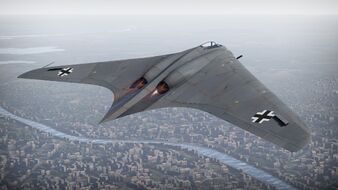Horten Ho 229[]
The Horten H.IX, RLM designation Ho 229 (often called Gotha Go 229 because of the identity of the chosen manufacturer of the aircraft)

Variants in War Thunder, Horten H.IX - Picture of the War Thunder.
Was a German prototype fighter/bomber designed by Reimar and Walter Horten and built by Gothaer Waggonfabriklate in World War II. It was the first pure flying wing powered by jet engines.
The design was a response to Hermann Göring's call for light bomber designs capable of meeting the "3×1000" requirement; namely to carry 1,000 kilograms (2,200 lb) of bombs a distance of 1,000 kilometres (620 mi) with a speed of 1,000 kilometres per hour (620 mph).
Only jets could provide the speed, but these were extremely fuel hungry so considerable effort had to be made to meet the range requirement. Based on a flying wing, the Ho 229 lacked all extraneous control surfaces, lowering drag. It was the only design to come even close to the 3×1000 requirements, and received Göring's approval. Its ceiling was 15,000 metres (49,000 ft).
Since the appearance of the B-2 Spirit flying wing stealth bomber in the 1990s, its similarities in role and shape to the Ho 229 has led many to retrospectively describe the Ho 229 as "the first stealth bomber".
A static reproduction of the only surviving Ho 229 prototype, the Ho 229 V3, in American hands since the end of World War II was later tested by the U.S. military who found the basic shape, paint and laminating adhesive composition of the mockup copy would provide for 37% reduction in detection range against the British Chain Home radar of the 1940s, but no significant stealth benefit against most other contemporary radar systems.
Restored Model[]
Stealth technology[]
this is complete veraboo bullshit. the Horton Ho was not a stealth bomber and the only reason that it was portrayed as such is because the engineers who designed it wanted jobs in NATO and claiming that they made a stealth bomber was an easy way to do that. please stop perpetuating these stupid, idiotic myths and think before you spew bullshit out of every orifice above your waist. delete this I dare you. you will only be proving my point
Engineers of the Northrop-Grumman Corporation had long been interested in the Ho 229, and several of them visited the Smithsonian Museum's facility in Silver Hill, Maryland in the early 1980s to study the V3 airframe. A team of engineers from Northrop-Grumman ran electromagnetic tests on the V3's multilayer wooden center-section nose cones. The cones are three-quarters of an inch (19 mm) thick and made up of thin sheets of veneer. The team concluded that there was indeed some form of conducting element in the glue, as the radar signal attenuated considerably as it passed through the cone.
Variants in War Thunder[]
Horten H.IX or Ho.229/Go.229
Specifications (Horten Ho 229A (V3))[]
General characteristics
- Crew: 1
- Length: 7.47 m (24 ft 6 in)
- Wingspan: 16.76 m (55 ft 0 in)
- Height: 2.81 m (9 ft 2 in)
- Wing area: 50.20 m² (540.35 ft²)
- Empty weight: 4,600 kg (10,141 lb)
- Loaded weight: 6,912 kg (15,238 lb)
- Max. takeoff weight: 8,100 kg (17,857 lb)
- Powerplant: 2 × Junkers Jumo 004B turbojet, 8.7 kN (1,956 lbf) each
Performance
- Maximum speed: 977 km/h (estimated) (607 mph) at 12,000 metres (39,000 ft)
- Service ceiling: 16,000 m (estimated) (52,000 ft)
- Rate of climb: 22 m/s (estimated) (4,330 ft/min)
- Wing loading: 137.7 kg/m² (28.2 lb/ft²)
- Thrust/weight: 0.26
Armament
- Guns: 2 × 30 mm MK 108 cannon
- Rockets: R4M rockets
- Bombs: 2 × 500 kilograms (1,100 lb) bombs
Pros
- Turns as fast if not faster than a bi-plane.














